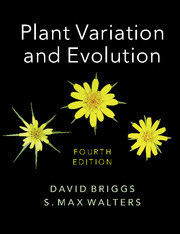Book contents
- Frontmatter
- Contents
- Preface to the Fourth Edition
- Acknowledgements
- Note on names of plants
- List of abbreviations
- 1 Investigating plant variation and evolution
- 2 From Ray to Darwin
- 3 Early work on biometry
- 4 Early work on the basis of individual variation
- 5 Post-Darwinian ideas about evolution
- 6 DNA: towards an understanding of heredity and molecular evolution
- 7 Breeding systems
- 8 Intraspecific variation and the ecotype concept
- 9 Pattern and process in plant populations
- 10 Pattern and process: factors interacting with natural selection
- 11 Populations: origins and extinctions
- 12 Species and speciation: concepts and models
- 13 Allopatric speciation and hybridisation
- 14 Abrupt speciation
- 15 The species concept
- 16 Flowering plant evolution: advances, challenges and prospects
- 17 Historical biogeography
- 18 The evolutionary impact of human activities
- 19 The taxonomic challenge ahead
- 20 Conservation: from protection to restoration and beyond
- Glossary
- References
- Index
11 - Populations: origins and extinctions
Published online by Cambridge University Press: 05 June 2016
- Frontmatter
- Contents
- Preface to the Fourth Edition
- Acknowledgements
- Note on names of plants
- List of abbreviations
- 1 Investigating plant variation and evolution
- 2 From Ray to Darwin
- 3 Early work on biometry
- 4 Early work on the basis of individual variation
- 5 Post-Darwinian ideas about evolution
- 6 DNA: towards an understanding of heredity and molecular evolution
- 7 Breeding systems
- 8 Intraspecific variation and the ecotype concept
- 9 Pattern and process in plant populations
- 10 Pattern and process: factors interacting with natural selection
- 11 Populations: origins and extinctions
- 12 Species and speciation: concepts and models
- 13 Allopatric speciation and hybridisation
- 14 Abrupt speciation
- 15 The species concept
- 16 Flowering plant evolution: advances, challenges and prospects
- 17 Historical biogeography
- 18 The evolutionary impact of human activities
- 19 The taxonomic challenge ahead
- 20 Conservation: from protection to restoration and beyond
- Glossary
- References
- Index
Summary
Populations do not exist in isolation: they owe their origin to pre-existing populations. Thus, populations establish, flourish, languish, decline and revive, and finally, for all manner of reasons, become extinct (Harper, 1977).
Metapopulations
A family of metapopulation models linking all these stages has proved important in the study of animal populations – from kangaroo rats to monk seals, from mountain sheep to butterflies. The concept has also influenced the study of plants.
Models take as their starting point that species occur in patches. At any one time some but not all suitable patches are likely to be occupied. Unoccupied patches are colonised by dispersal of seeds or fruits from an occupied patch. In time, while populations in newly occupied sites may expand, eventually numbers may decline and the population becomes extinct. Each population, therefore, has a finite life. Thus, the success of the species regionally will depend upon there being healthy colonies from which recolonisation can repopulate empty patches, where the species has become extinct. Brussard (1997) describes three different types. (i) ‘Classical metapopulations consist of several small extinction-prone local populations connected by a moderate amount of migration’. (ii) Mainland populations or large habitat blocks that supply colonists to small outlying island populations, including islands of land in the sea or lakes; ‘island’ water bodies scattered across a landscape; and isolated mountain tops in a lowland plain etc. (iii) Metapopulation systems may also consist of populations that ‘are declining to extinction because dispersal is too infrequent’ or does not occur to facilitate re-establishment.
The metapopulation concept has been employed in interpreting patterns of behaviour in plant populations. For example, Pedicularis furbishiae has been studied at sites along the banks of the St John River in Maine, USA. A total of 28 colonies were mapped over a four-year period, and the patterns of colonisation/extinction were consistent with the metapopulation model (Menges, 1990, 1991).
In another case study employing metapopulation models, populations of the short-lived perennial species Silene latifolia (S. alba) were examined over a number of years in roadside habitats in Virginia, USA (see Altizer, Thrall & Antonovics 1998; Thrall et al., 1998). Overall, 7500 habitat patches were detected, of which some 400–500 were occupied in any one year.
- Type
- Chapter
- Information
- Plant Variation and Evolution , pp. 216 - 241Publisher: Cambridge University PressPrint publication year: 2016
- 2
- Cited by



